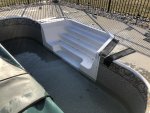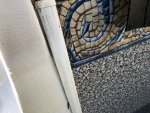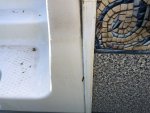I've got a persistent leak around my in wall stairs. During the colder months when my pool is winterized, my water level drops to the lower, horizontal flange of my stairs. At that point, it stops leaking so I know that the leak is at that level. The only break in the liner at this level is the stair flange. I've had some luck in the past caulking with pool rated silicone; however, this hasn't produced a permanent fix for the leak. The liner is 6 years old and in great condition so I'd hate to have to replace the liner at this point.
I'd like to remove the flanges (one side at a time) and replace the gasket under the liner in an attempt to fix the leak. I'm hesitant to do this because obviously if the liner shifts and I can't get it back into place its probably going to turn into a liner replacement. Would it be better to attempt to seal around the edge of the flange/liner with one of these product from Anderson Manufacturing (Flexible Sealer 4 oz. Tube - White , https://www.leaktools.com/leakmaster-pool-glue-5400.html)?
Does anyone have any experience in removing and replacing this gasket and if so, how did you make the repair? Did you run into any unforeseen problems while attempting this repair? What gasket material did you use?
I'd like to make this repair now during the winter months so that I can refill the pool and allow it to sit until spring so I can see if it still leaks, which may also be problematic since the liner will be less pliable in the colder temperatures. Any thoughts, concerns or recommendations are much appreciated.
I'd like to remove the flanges (one side at a time) and replace the gasket under the liner in an attempt to fix the leak. I'm hesitant to do this because obviously if the liner shifts and I can't get it back into place its probably going to turn into a liner replacement. Would it be better to attempt to seal around the edge of the flange/liner with one of these product from Anderson Manufacturing (Flexible Sealer 4 oz. Tube - White , https://www.leaktools.com/leakmaster-pool-glue-5400.html)?
Does anyone have any experience in removing and replacing this gasket and if so, how did you make the repair? Did you run into any unforeseen problems while attempting this repair? What gasket material did you use?
I'd like to make this repair now during the winter months so that I can refill the pool and allow it to sit until spring so I can see if it still leaks, which may also be problematic since the liner will be less pliable in the colder temperatures. Any thoughts, concerns or recommendations are much appreciated.




